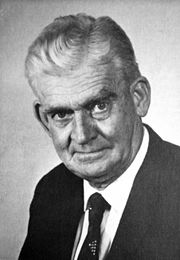
John Phillip Harison Acocks
Encyclopedia

Cape Town
Cape Town is the second-most populous city in South Africa, and the provincial capital and primate city of the Western Cape. As the seat of the National Parliament, it is also the legislative capital of the country. It forms part of the City of Cape Town metropolitan municipality...
- 20 May 1979 Middelburg, Eastern Cape
Middelburg, Eastern Cape
Middelburg is a town in the Eastern Cape province of South Africa, in the Great Karoo. It lies in the Upper Karoo, 1 279 m above sea level, with a population of 44000...
), was a South African botanist noted for his publication "Veld Types of South Africa" and his extensive botanical collection of some 28 000 specimens from South Africa and Namibia
Namibia
Namibia, officially the Republic of Namibia , is a country in southern Africa whose western border is the Atlantic Ocean. It shares land borders with Angola and Zambia to the north, Botswana to the east and South Africa to the south and east. It gained independence from South Africa on 21 March...
. In 1938 he was seconded to go on a joint collecting trip of four months with Swedish botanist Adolf Hjalmar Frederick Hafström (1871-1948) between Cape Town and Victoria Falls
Victoria Falls
The Victoria Falls or Mosi-oa-Tunya is a waterfall located in southern Africa on the Zambezi River between the countries of Zambia and Zimbabwe.-Introduction:...
.
He was born in Cape Town to John Martin Acocks and Sarah Phoebe Petty. Matriculated from the South African College Schools
South African College Schools
The South African College Schools, commonly referred to as SACS, is a primary and secondary education institution located in Newlands, Cape Town, South Africa. Founded in 1829, it is the oldest school in South Africa and one of four schools expressly named by Cecil John Rhodes to offer an annual...
(SACS) and attended the University of Cape Town
University of Cape Town
The University of Cape Town is a public research university located in Cape Town in the Western Cape province of South Africa. UCT was founded in 1829 as the South African College, and is the oldest university in South Africa and the second oldest extant university in Africa.-History:The roots of...
between 1929-35 obtaining a B.A.
Bachelor of Arts
A Bachelor of Arts , from the Latin artium baccalaureus, is a bachelor's degree awarded for an undergraduate course or program in either the liberal arts, the sciences, or both...
and M.Sc.. He studied under Robert Stephen Adamson (1885-1965) and Margaret Levyns
Margaret Levyns
Margaret Rutherford Bryan Levyns was an eminent South African phytogeographer, botanist and taxonomist....
(1890-1975).
His first appointment was in January 1936 as pasture ecologist at the Pasture Research Section, part of the Division of Plant Industry. He set out to do botanical surveys of new pasture research stations. In 1945 he was transferred to Estcourt
Estcourt, KwaZulu-Natal
Estcourt is a town in the uThukela District of KwaZulu-Natal Province, South Africa. The main economic activity is farming with large bacon and processed food factories situated around the town. The N3 freeway passes close to the town, linking it to the rest of South Africa.-Location:Estcourt is...
to the Botanical Survey Section of the Division of Botany and Plant Pathology which later became the Botanical Research Institute. From 1948 he was permanently posted at the Grootfontein College of Agriculture in Middelburg.
Acocks contributed greatly to South African botany in three distinct areas. Firstly, his treatment of the vegetation regions (Veld Types) of South Africa, in which he classifies vegetation into 75 classes, continues to be a valuable reference work for researchers and is an outstanding achievement for a single individual. Secondly, his analysis of the impact of humans on vegetation has largely been revised by current research insights, specifically with regard to the effect of fire on grasslands, savannas and forests. There is, though, ample evidence showing considerable changes in Karoo fauna and flora over the last three centuries. Finally, his pioneering views on veld rehabilitation and management remain important guidelines for the farming communities of South Africa.
He was President of Section C of the SA Assoc. for the Advancement of Science in 1963, and awarded the Senior Capt. Scott Medal by the SA Biol. Soc. in 1977.
Acocks is commemorated by many specific names including Cliffortia acocksii H.Weim., Erica acocksii Compton, Restio acocksii Pillans and Diospyros acocksii De Wint. His specimens are housed at BM, BOL, Cedara College of Agriculture
Cedara College of Agriculture
Cedara College of Agriculture is an agricultural college and research station near Howick, KwaZulu-Natal, South Africa, founded partly by Thomas Robertson Sim. The foundation stone of the "School of Agriculture and Forestry" was laid on 28 April 1905...
, Dohne
Döhne
Döhne is a South African agricultural research station 6 kilometers north of Stutterheim in the Eastern Cape. It is noted for having developed the Döhne Merino from Peppin Merino ewes and German mutton merino sires in 1939. The program bred for high fertility, rapid lamb growth and fine wool...
Agricultural Development Institute, GRA, Grootfontein Agricultural College, K, KMG, M, MO, NH, NU, P, PRE, PREM, S, STE(NBG), Towoomba Agricultural Development Centre.
Acocks worked on a revised version of the Veld Types, which he completed shortly before his death, and which is lodged in the archives of the National Botanical Institute (NBG). His second book, Key Grasses of South Africa, was published in 1990.

